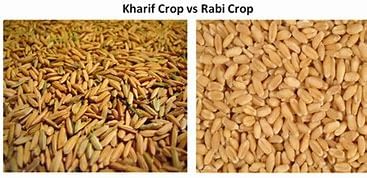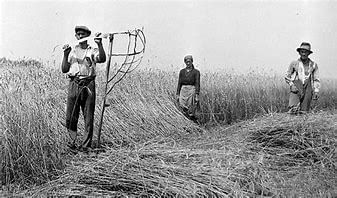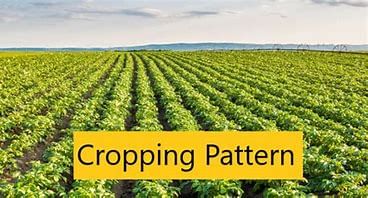Ramesh Singh Summary: Agriculture & Food Management- 1 | Indian Economy for UPSC CSE PDF Download
Agriculture remains the most important sector of the Indian economy, whether it be the pre¬ independence or the post-independence periods. This fact is emphatically proved by the large number of people who depend on it for their livelihood.
Kharif and Rabi
- India's agricultural crop year spans from July to June, divided into two main seasons: kharif and rabi based on monsoon patterns.
- Kharif season runs from July to October during the South-West/Summer Monsoon, while rabi season spans from October to March (North-East/Returning/Winter Monsoon).
- Summer crops, known as zaid, are grown between March and June.
- Other countries like Pakistan and Bangladesh also use the terms 'kharif' and 'rabi' to describe their cropping patterns.
- The terms 'kharif' and 'rabi' have origins in Arabic, where 'kharif' means autumn and 'rabi' means spring.

Kharif Crops:
- Rice, maize, sorghum, pearl millet/bajra, finger millet/ragi are some of the kharif crops in the cereals category.
- Arhar (pulses), soyabean, groundnut (oilseeds), cotton, etc., are also among the kharif crops.
Rabi Crops:
- Wheat, barley, oats are some of the rabi crops in the cereals category.
- Chickpea/gram (pulses), linseed, mustard (oilseeds) are also part of the rabi crops.
Food Philosophy of India
Indian Food Philosophy is generally seen divided into three phases with their own objectives and challenges:

First Phase: Post-Independence
- The primary focus was on ensuring physical access to sufficient food grains for the Indian population.
- By the late 1980s, India achieved self-sufficiency in food production, largely due to the Green Revolution.
Second Phase: Economic Access to Food
- While celebrating the successes of the first phase, India faced the challenge of providing economic access to food.
- Despite having excess food stocks in central reserves, certain regions experienced severe food shortages, leading to a crisis.
- The Supreme Court intervened, prompting the implementation of initiatives like the National Rural Employment Guarantee Scheme.
- India resorted to exporting surplus wheat due to the inability of many citizens to afford food, despite increased subsidies.
- The Green Revolution, while boosting production, also led to higher costs, exacerbating the affordability issue.
- Current Challenges and Solutions
- India continues to grapple with economic disparities in accessing food.
- Efforts are underway to enhance employment opportunities and reduce food costs through initiatives like the second green revolution.
- The country aims to address food insecurity by increasing purchasing power and promoting biotechnology in agriculture.
The Third Phase
- By the late 1980s, global experts began to question the prevailing methods of production worldwide, with a particular focus on agriculture. This sector had increasingly relied on industrial practices such as chemical fertilizers, pesticides, and machinery like tractors. Most advanced economies had designated agriculture as an industry.
- A period of reflection and reevaluation commenced. In the early 1990s, numerous nations began transitioning towards environmentally sustainable approaches in the industrial, agricultural, and service sectors. The once highly acclaimed Green Revolution was deemed environmentally unsustainable, leading the world towards practices like organic farming and green agriculture.
- This shift signified that the challenge for India was not merely ensuring physical and economic access to food. It also entailed safeguarding the environment and biodiversity. This new perspective presented a fresh challenge. India required a novel form of agricultural transformation that could provide not only physical and economic food security but also ecological sustainability—a comprehensive approach known as the Second Green Revolution
Land Reforms
Land reforms in India have evolved in two phases, reflecting changing priorities over time.
Phase 1: Post-Independence
- This phase began immediately after India gained independence.
- Agrarian reforms were crucial as India transitioned from an agrarian to an industrial economy.
- Key Objectives of Land Reforms:
- Addressing institutional disparities inherited from the past, such as land ownership, tenancy reforms, and abolishing intermediaries.
- Tackling socio-economic inequalities amplified by unequal land distribution tied to the caste system.
- Enhancing agricultural productivity to combat poverty, malnutrition, and food insecurity.
- Social Impact:
- More than 80% of the population relied on agriculture for sustenance, highlighting the significance of land reforms in improving livelihoods.
- Land reforms faced criticism for being perceived as government land-grabbing efforts.
Objectives of Land Reforms in India
To achieve the goals of land reforms in India, the government implemented three major steps, each comprising several internal sub-steps:
1. Abolition of Intermediaries
- Elimination of Exploitative Land Tenure Systems
- Zamindari, Mahalwari, and Ryotwari systems were completely abolished.
2. Tenancy Reforms
- Rent Regulation: Implemented to ensure that share-croppers paid a fixed and fair rent to landowners.
- Tenure Security: Provided security of tenure to share-croppers, ensuring stability in their future income.
- Ownership Rights for Tenants: Granted landless masses ownership rights, allowing tenants to have final ownership of the land they cultivated - "land to the tillers."
3. Reorganization of Agriculture
- Land Redistribution: Attempted redistribution of land among the landless poor following the enforcement of timely ceiling laws. Notably, this effort faced significant challenges and limited success, with exceptions in states like West Bengal, Kerala, and partially Andhra Pradesh.
- Land Consolidation: Succeeded mainly in regions experiencing the Green Revolution (e.g., Haryana, Punjab, western Uttar Pradesh) but encountered various issues such as loopholes and corruption.
- Cooperative Farming: Although cooperative farming held significant socio-economic potential, it was often manipulated by large landowners to circumvent restrictive ceiling laws, thus limiting its intended impact.
Outcome and Impact
- Effectiveness and Failures: Overall, the land reform initiatives in India are widely regarded as unsuccessful by a majority of experts.
- Tenancy Reforms: Only 4% of India's total operated areas (14.4 million hectares) were covered by tenant rights by 1992.
- Land Ownership Redistribution: Merely 2% of the country's total operated area (less than 2 million hectares out of 4.76 million people) witnessed the transfer of ownership rights by 1992.
- Overall Impact: The entire land reform process benefited a mere 6% of the country's operated area, with minimal socio-economic improvements.
- Shift to Green Revolution: Due to the failure of land reforms to enhance agricultural production, the government transitioned towards the Green Revolution strategy, emphasizing increased productivity through new agricultural techniques.
Reasons for Failure of Land Reforms
- Land in India is viewed as a symbol of social status and identity rather than just an economic asset for income generation as in successful economies.
- Lack of necessary political determination to implement effective land reforms.
- Widespread corruption in public life, political insincerity, and leadership inadequacy within the Indian democratic system.
Land Reforms & Green Revolution
Green Revolution overshadowed the issue of land reforms due to several reasons:- An intrinsic conflict exists between the Green Revolution and land reforms since the former favors larger, economically viable land holdings while the latter aims to distribute land among the masses.
- Land-owning caste groups opposed land reforms socially, whereas the Green Revolution faced no such opposition.
- Legislative efforts concerning land reforms have had minimal positive socio-economic effects compared to the Green Revolution, which promised increased foodgrain yields.
- Subsidized foodgrain supplies under PL480 hindered India's diplomatic independence and raised concerns about consistent wheat supplies.
- International pressures, World Bank recommendations, and success stories from countries benefiting from the Green Revolution influenced India's decisions.
PHASE-II
- The second phase of land reforms emerged during economic reforms, addressing issues like land acquisition, leasing, and agricultural provisions of the WTO.
- Government focus shifted towards land reforms, outlining a three-step policy: careful land mapping, fair land acquisition processes, and transparent land leasing policies.
- Land holds immense value in the nation, offering liquidity for efficient resource deployment and acting as collateral for credit.
- The NLRMP initiative aims to digitize land records by the end of the 12th Plan, transitioning from presumptive to conclusive land titles.
Digitization Benefits:
- Digital records reduce land transaction costs.
- Conclusive titles remove legal uncertainties.
- Acceleration of NLRMP: Swift rollout in states aids small and medium enterprises lacking legal support.
- Impact of Land Leasing Norms:
- Restrictions on land leasing hinder rural-urban migration, affecting agricultural productivity.
- Lifting restrictions can enable efficient land use and facilitate skill mobility to non-agricultural sectors.
Leaseholds and Ownership:
- Compulsory registration safeguards tenants and landowners, fostering a secure leasing market.
- Long-term tenancy should not jeopardize ownership rights, promoting a vibrant leasing environment.
- Large-Scale Projects: Public projects like industrial zones may necessitate substantial land acquisition.
Challenges and Solutions:
- Balancing economic growth needs with the costs borne by displaced individuals is crucial.
- The Land Acquisition Bill of 2013 and subsequent proposals aim to ensure transparent, effective, and equitable land reforms.
- Opposition to newer bills underscores the necessity for comprehensive and fair laws in land acquisition and leasing processes.
Finer Points of Land Leasing vs. Land Acquisition
(a) Leasing as a Preferred Option:
- Leasing land is favored over acquisition due to recent opposition faced by India from farmers in various states towards land acquisition attempts.
- For attracting investments from the organized private sector, both domestic and foreign, leasing land appears to be a more suitable choice compared to acquisition.
(b) Significance of Corporate Farming:
- Corporate farming, especially in food grain production areas crucial for India's food security and competitiveness in global markets, remains limited.
- Given the Right to Food provided to a significant population segment, ensuring food security has become even more critical.
(c) Advantages of Prioritizing Leasing:
- Retains land ownership among existing farmers.
- Prevents mass landlessness and unemployment in farming communities.
- Provides farmers with a steady income source, potentially offering skill development opportunities and better employment prospects in industries.
- Makes land readily available for both public and private uses.
(d) Need for Enhanced Agriculture Production:
- To benefit from globalization, India must boost agriculture production to surplus levels, necessitating private sector investment.
- Effective land leasing and acquisition policies are vital for leveraging private sector investment potential in the agricultural sector.
(e) Interconnection of Sectors:
- Promotion of the manufacturing sector and smart cities heavily relies on efficient land acquisition processes.
- Expanding the industrial sector to optimal levels is crucial for making agriculture a lucrative profession and smoothly transitioning the surplus agricultural workforce to industries.
(f) Land Acquisition and Environmental Sustainability:
- Linking land acquisition with environmental concerns is essential for ensuring sustainable development.
- While the Government of India has shifted focus towards land reforms, state-level progress is hindered by resistance from land-owning factions.
Agriculture Holding

Land Holding Trends
- The size of land holdings in India is consistently decreasing due to rapid population growth, leading to increased fragmentation.
- Operational holdings in India increased from 129 million in 2005-06 to 138 million in 2010-11.
- The average size of operational holdings declined to 1.16 hectares in 2010-11 compared to 1.23 hectares in 2005-06.
Female Operational Holders
- The percentage share of female operational holders increased from 11.70% in 2005-06 to 12.79% in 2010-11.
- The corresponding operated area also increased from 9.33 to 10.36.
Size of Holdings
- In 2010-11, small and marginal holdings (below 2.00 hectares) constituted 84.97%, showing a slight increase from 83.29% in 2005-06.
- Large holdings (10.00 hectares & above) accounted for 0.73% of total holdings in 2010-11.
Social Groups in Holdings
- SCs accounted for 12.40%, STs for 8.71%, institutional holders for 0.18%, and others for 78.72% of operational holdings.
State-wise Distribution
- Uttar Pradesh had the highest number of operational holdings (22.93 million), followed by Bihar (16.19 million) and Maharashtra (13.70 million).
- Rajasthan contributed the most to the operated area with 21.14 million hectares.
Classification of Holdings
Agricultural holdings are categorized into three types:
- Economic Holding: Ensures a minimum satisfactory standard of living for a family.
- Family Holding: Provides work for an average-sized family with one plough.
- Optimum Holding: The maximum size of holding a family should possess for optimal cultivation.
Green Revolution
- It refers to the adoption of innovative agricultural methods known as the Green Revolution, which gained prominence in the early 1960s, initially focusing on wheat and later expanding to include rice production.
- This revolutionized conventional food production practices by significantly boosting productivity levels by over 250%.

Components of the Green Revolution
- The High Yielding Variety (HYV) Seeds
- These seeds, also known as the "dwarf variety," were developed through successive mutations to enhance nutrient distribution within the wheat plant, favoring grain production over leaves and stems. This led to increased yields.
- Unlike traditional seeds, these non-photosynthetic seeds did not rely on sunlight for optimal yields.
- Chemical Fertilizers: To maximize productivity, the HYV seeds required adequate nutrient levels from the soil. Traditional compost lacked the necessary nutrient concentrations and required more space for sowing, necessitating high-concentration chemical fertilizers like urea, phosphate, and potash.
- Irrigation: Controlled water supply was essential for crop growth and proper fertilizer dilution. This necessitated areas free from flooding and the development of artificial water supply systems.
- Chemical Pesticides and Germicides: Due to the vulnerability of new seeds to local pests and diseases, chemical pesticides and germicides were necessary to ensure successful yields.
- Chemical Herbicides and Weedicides: Herbicides and weedicides were utilized to prevent the wastage of fertilizers by herbs and weeds in farmlands where high-yielding variety (HYV) seeds were sowed.
- Credit, Storage, Marketing/Distribution
- Easy access to affordable credit was crucial for farmers to afford the new and costly inputs required by the Green Revolution.
- Storage of harvested crops in the region of production was essential, especially in areas like Haryana, Punjab, and western Uttar Pradesh in India, where the Green Revolution was concentrated.
- Development of infrastructure for marketing, distribution, and transportation was necessary to ensure the widespread dissemination of the increased yield, particularly in food-deficient nations opting for the Green Revolution.
- Countries implementing the Green Revolution, such as India, received financial support from institutions like the World Bank to develop the required infrastructure.
Impact of the Green Revolution
Socio-economic Impact
- Food production increased significantly during the Green Revolution, leading many countries, including India, to achieve self-sufficiency in certain crops, although this is distinct from ensuring food security.
- However, this period also saw a rise in income inequality among farmers, exacerbating interpersonal and inter-regional disparities within India.
- Negative impacts included a surge in malaria cases due to water-logging, a shift towards cultivating mainly wheat and rice at the expense of pulses, oilseeds, maize, and barley, pushing these crops to the margins.
Ecological Impact
- The Green Revolution had a profound negative ecological impact, triggering various concerns raised by the media, scholars, experts, and environmentalists.
- Initially, there was little acknowledgment of these issues by governments or the general public, especially farmers in Green Revolution regions who lacked awareness of the long-term consequences of the Revolution's practices.
- Over time, governmental and non-governmental bodies initiated studies to investigate ecological and environmental concerns, revealing critical ecological crises in the Green Revolution areas.
- These crises included soil degradation due to repetitive cropping patterns, declining water tables caused by the high water requirements of new seeds, and environmental degradation from the excessive use of chemical fertilizers, pesticides, and herbicides.
- Consequently, there was a rise in pollution levels in land, water, and air, particularly notable in India due to factors like deforestation, expansion of cultivation in ecologically fragile zones, and increased pressure from livestock on forests.
- An alarming consequence was the heightened toxic levels in the Indian food chain, rendering much of the locally produced food unfit for human consumption. This was primarily attributed to the unchecked use of chemical pesticides and weedicides, leading to widespread pollution of land, water, and air.
Cropping Patterns

- The cropping pattern in a region refers to the specific combination of crops chosen by farmers for their agricultural practices.
- India's agriculture has traditionally featured a diverse range of cropping systems, largely influenced by rainfed agriculture and the socio-economic conditions of the farming community.
- Changes in India's cropping patterns have been driven by factors such as population growth, urbanization, and the consequent increased demand for food.
- Due to the limited availability of cultivable land, there is pressure on agricultural lands, leading to crop intensification and the substitution of food crops with commercial crops.
- The choice of cropping systems in a region is primarily determined by various soil and climatic factors that create the agro-ecological conditions suitable for specific crops.
- Farmers make decisions based on factors like potential productivity and economic benefits when selecting crops or cropping systems.
- Several external forces influence farmers' decisions, including geographical factors (such as soil type, precipitation, altitude), socio-cultural factors (like food habits and traditions), infrastructure factors (such as irrigation and transport facilities), economic factors (including financial resources and land ownership), and technological factors (such as access to improved seeds and machinery).
- For instance, a farmer in a region with limited rainfall may opt for drought-resistant crops, while another farmer in a well-irrigated area might choose high-yield varieties that require abundant water.
Prevalent Cropping System
Multiplicity of Cropping Systems in Indian Agriculture- Rainfed agriculture covers over 92.8 million hectares, constituting 65% of the cropped area.
- Intercropping is prevalent due to the risks associated with cultivating large areas under a single crop.
- A diverse range of cropping systems exists in rainfed and dryland regions.
Socio-Economic Factors Influencing Cropping Systems
- Factors such as small landholdings, high population pressure on land, and dependency on agriculture influence cropping systems.
- Food security is a paramount concern for millions of Indian farmers due to prevailing socio-economic conditions.
- Most farmers in India practice subsistence farming, growing multiple crops to meet household needs.
Characteristics of Cropping Systems in India
- Subsistence farming is common, with farmers rotating crop combinations over 3 to 4 years.
- Over 250 double cropping systems are estimated to be practiced across the country.
- 30 important cropping systems have been identified based on the spread of crops in each district.
Changes in the Cropping Pattern
Pre-Green Revolution period
In the time preceding the Green Revolution, Indian farmers followed cropping systems largely influenced by socio-cultural and economic factors.
These systems, which were relatively sustainable, had evolved over generations through trial and error. Farmers cultivated a mix of crops across the country, tailored judiciously until the onset of the Green Revolution.
This era was characterized by subsistence farming, with the population heavily reliant on it for livelihood. The cropping patterns during this phase were resistant to change, even in the presence of incentives.
Green Revolution period
The Green Revolution, catalyzed by the New Agricultural Strategy, marked a significant transition in the cropping patterns of Indian farmers from 1965 onwards.
Economic, infrastructural, and technological factors drove this change. Introduction of high-yielding seed varieties, financial assistance for inputs like chemicals, and the establishment of minimum support prices (MSP) significantly influenced farmers' crop choices.
Regions under Green Revolution witnessed a dominant "wheat-rice" cropping pattern. Subsequently, the government extended MSPs to various other crops, impacting farmers' decisions within their cropping systems.
The primary goal during this period was achieving food self-sufficiency, which India eventually accomplished by the late 1980s. The emergence of large farmers in Green Revolution regions marked a shift towards commercial farming, departing from traditional subsistence practices.
Reform period
The reform period, initiated with economic reforms in 1991, ushered in new opportunities and challenges in the agricultural sector. Policymakers faced pressure to ensure food security as foodgrain production struggled to keep pace with population growth. Globalization presented prospects for farm exports but also demanded cost-effective production methods to compete globally, necessitating mechanization and commercialization.
Recognizing the need for ecologically sustainable practices due to climate change risks and environmental constraints, India began considering substantial investments in the sector. Acknowledging agriculture as an industry in 2000, the country embraced corporate and contract farming.
The looming threat of climate change prompted the proposal for a Second Green Revolution in 2002, incorporating genetically modified foods (GMFs). Anticipating significant shifts in cropping patterns, experts and authorities deliberated on strategies to tackle emerging challenges and promote sustainable farming practices.
Key Recommendations for Agricultural Policy
- Putting in place appropriate agricultural policies that incentivize farmers to adopt the right cropping patterns through a system of rewards and penalties.
- Evolving trade policies that safeguard Indian agricultural products from global competition, facilitating export expansion.
- Implementing favorable labor laws, land leasing regulations, and acquisition policies to encourage the participation of Indian and foreign private sectors in agriculture.
- Advocating at the WTO for a fair agricultural regime that considers India's subsistence farming and challenges related to high agricultural subsidies in developed countries.
- Establishing a conducive policy framework for the introduction of Genetically Modified Foods (GMFs) in the agricultural sector, while also supporting non-GMF research and development.
- Incorporating environmental and climate change considerations into agricultural policy frameworks.
- Highlighting the importance of farmer education and awareness in adapting to changing circumstances, with a significant role for Panchayati Raj Institutions (PRIs).
- Addressing issues such as plant protection, farm waste reduction, pest control, commercial production, and the availability of agricultural inputs.
- Developing appropriate credit and insurance policies for the agricultural sector at both macro and micro levels.
- Integrating additional factors into the agricultural sector, including the establishment of a national market for agricultural products, effective supply chain management, logistics, agro-processing industries, and storage facilities.
Natural Farming

Natural farming is a chemical-free alternative to traditional farming methods. It is an agroecology-based diversified farming system, integrating crops, trees, and livestock with functional biodiversity.
- Main Objectives:
- Elimination of chemical inputs from farm practices.
- Adoption of good agronomic practices for chemical-free produce.
- Restoring soil fertility.
- Reducing water usage.
- Promoting sustainable and climate-friendly farming.
- Based on:
- On-farm biomass recycling.
- Emphasis on biomass mulching.
- Use of on-farm cow dung-urine.
- Periodic soil aeration.
- Exclusion of all synthetic chemical inputs.
- Government Initiatives:
- Promoted under schemes like BPKP (Bharatiya Prakritik Krishi Paddhati Programme, 2021) and PKVY (Paramparagat Krishi Vikas Yojana, 2018).
- Financial assistance of ₹12,200/ha for 3 years provided for cluster formation, capacity building, handholding, certification, and residue analysis.
- Various Forms of Organic Farming Promoted:
- Homa Farming.
- Cow Farming.
- Vedic Farming.
- Zero Budget Natural Farming (ZBNF).
- Adoption and Effectiveness:
- Adopted in several states like Andhra Pradesh, Karnataka, Himachal Pradesh, Gujarat, Uttar Pradesh, and Kerala.
- Studies report its effectiveness (as per Niti Aayog, February 2022).
- Around 2.5 million farmers practiced regenerative agriculture by 2021, expected to reach 20 lakh hectares in the next 5 years.
- Union Budget 2022-23:
- Plans to spread natural farming throughout the country.
- Initial stage to start within a 5-km wide corridor along the river Ganges.
- Encourages states to revise agricultural university syllabi to meet the needs of natural, zero-budget, and organic farming.
Crop Diversification
Crop diversification, or crop shift, involves integrating alternative or new crops into regional cropping systems. According to the FAO, in India, it is commonly seen as a transition from traditionally grown less profitable crops to more lucrative ones.

- Purpose and Benefits:
- Tool for promoting sustainable agriculture.
- Reduction in import dependence.
- Potential for higher incomes for farmers.
- DFI (Doubling Farmers Income) Committee suggests that shifting from staple cereals to high-value produce can significantly increase returns for farmers, enhance water use efficiency, and promote soil health sustainability.
- Challenges with Existing Cropping Pattern:
- Skewed towards cultivation of sugarcane, paddy, and wheat.
- Resulted in the depletion of fresh groundwater resources in many parts of the country.
- Regions growing crops like paddy, wheat, and sugarcane face high to extremely high baseline water stress levels.
- Crop Diversification Programme (CDP):
- A centrally-sponsored scheme since 2013-14, implemented under RKVY (Rashtriya Krishi Vikas Yojana, 2007).
- Objectives:
- Shift green revolution states (e.g., Punjab, Haryana, and Western UP) from paddy to alternative crops like pulses, oilseeds, maize, coarse cereals, nutri cereals, cotton, and agroforestry.
- Address depleting water tables and declining soil fertility in these states.
- Expansion in 2015-16 to include tobacco, aiming to shift areas under tobacco farming to alternative crops in tobacco-growing states.
- Economic Survey Findings:
- As per the Economic Survey of 2022-23 and 2021-22, the Government's minimum support prices have played a role in encouraging crop diversification in the country.
Millets

International Year of Millets (IYM) - 2023:
- The UNO has designated the year 2023 as the International Year of Millets (IYM) to align with various UN Sustainable Development Goals (SDGs).
- Millets are recognized as "smart food" due to their high nutritional value, offering substantial potential for livelihood generation, increased farmers' income, and ensuring global food and nutritional security.
- Initiatives by the Government:
- The Indian government officially categorized millets as Nutri-cereals in April 2018.
- As part of the National Food Security Mission (NFSM), millets have been included to provide nutritional support, with a specific sub-mission implemented since 2018-19 in 212 districts across 14 states.
- Startup Engagement:
- India boasts more than 500 startups actively participating in the millet value chains.
- The Indian Institute of Millets Research, under the Rashtriya Krishi Vikas Yojana-Remunerative Approaches for Agriculture and Allied Sectors Rejuvenation (RKVY-RAFTAAR), has incubated 250 startups.
- Economic Survey Insights:
- India's millet production exceeds 50.9 million tonnes, accounting for 80% of Asia's and 20% of global production.
- The average yield of millets in India (1239 kg/ha) surpasses the global average (1229 kg/ha).
- Millets in India are primarily grown as a kharif crop under rainfed conditions, demanding less water and agricultural inputs compared to other staple crops.
Recent Developments in Agriculture and Food Management
As of 2025, Indian agriculture has undergone significant transformation, driven by technological advancements, policy reforms, and the need for sustainability. Below are the key recent developments:
- Technological Advancements: Precision farming, drones, and AI-based crop management tools have become mainstream, improving productivity and reducing input costs. Over 10 million farmers now use mobile apps for real-time weather and market information.
- Doubling Farmers' Income: The government’s target to double farmers’ income by 2022 has been extended to 2025, with schemes like PM-KISAN, e-NAM, and the Agriculture Infrastructure Fund (AIF) playing pivotal roles. By 2025, average farmer income has increased by 60%, though regional disparities persist.
- Agricultural Exports: India’s agricultural exports crossed $50 billion in 2024, with rice, spices, and marine products leading the way. New trade agreements with the UAE, Australia, and the UK have opened markets for Indian farm produce.
- Climate Resilience: The National Adaptation Fund for Climate Change (NAFCC) has funded over 100 projects to promote climate-resilient agriculture, including drought-tolerant crop varieties and water-efficient irrigation systems.
- R&D in Agriculture: New crop varieties, such as flood-tolerant rice and heat-resistant wheat, have been developed by ICAR. The use of gene editing and biotechnology is being explored to enhance crop resilience.
- Farm Laws and Reforms: After the repeal of the 2020 farm laws, the government has focused on strengthening FPOs and cooperatives. The Model Contract Farming Act, 2018, has been adopted by 15 states, promoting private investment in agriculture.
- Rural Infrastructure: Under the PM Gram Sadak Yojana (PMGSY), over 99% of eligible habitations have been connected by all-weather roads. The AIF has sanctioned ₹1.5 lakh crore for storage, processing, and marketing infrastructure.
- Sustainable Agriculture: Natural farming, organic farming, and conservation agriculture are being promoted through schemes like PKVY and BPKP. Over 5 million farmers have adopted natural farming, covering 3 million hectares by 2025.
- Access to Credit and Insurance: Kisan Credit Cards (KCC) have been issued to over 3 crore farmers, with credit limits exceeding ₹20 lakh crore. The Pradhan Mantri Fasal Bima Yojana (PMFBY) has insured over 50 crore farmer applications since its inception.
- Agricultural Production: India’s foodgrain production reached 320 million tonnes in 2024-25, with record outputs of wheat (115 million tonnes) and rice (130 million tonnes). However, climate change poses ongoing challenges, with erratic monsoons affecting yields in rainfed areas.
These developments reflect India’s commitment to modernizing agriculture while addressing sustainability and food security challenges, making them essential for UPSC aspirants to understand.
|
139 videos|431 docs|128 tests
|
FAQs on Ramesh Singh Summary: Agriculture & Food Management- 1 - Indian Economy for UPSC CSE
| 1. What is the significance of agriculture in India? |  |
| 2. How does India manage its food production and distribution? |  |
| 3. What are the challenges faced by Indian farmers in food management? |  |
| 4. How does India ensure food security for its population? |  |
| 5. What are the major crops grown in India? |  |

















